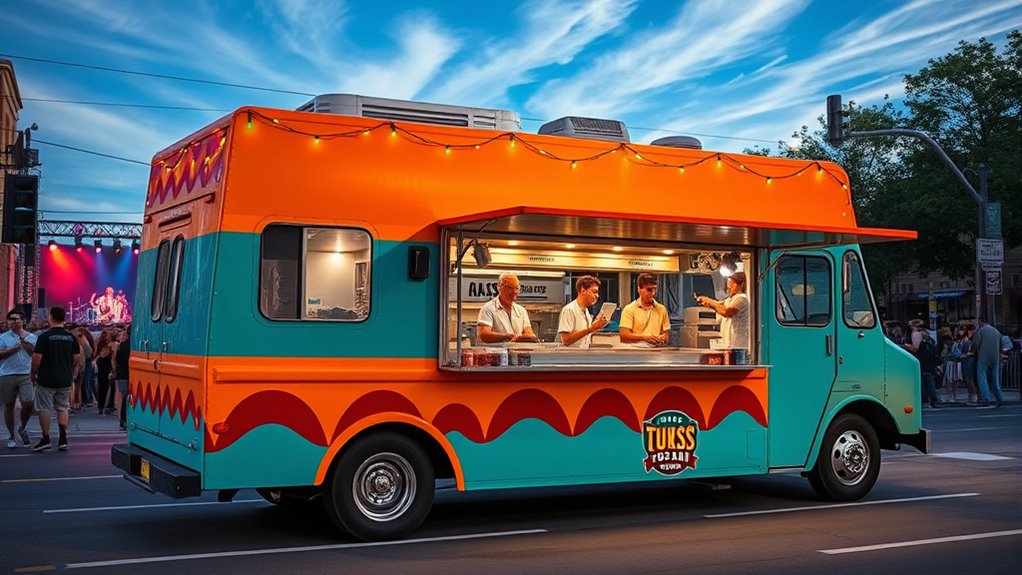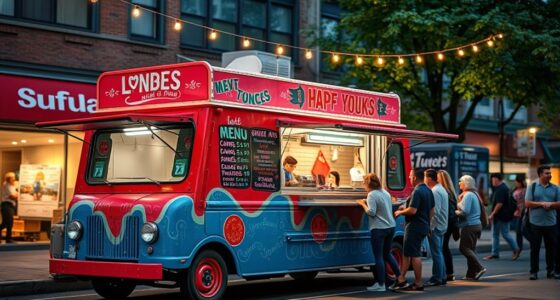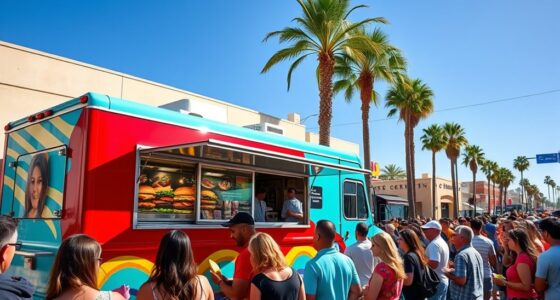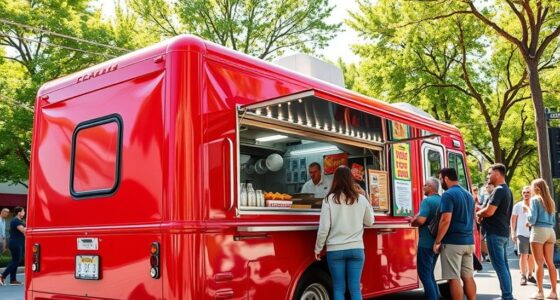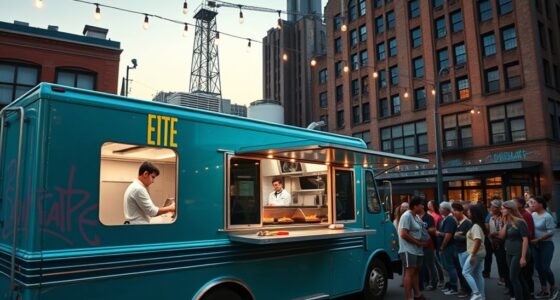Starting a food truck in Austin, TX, means tapping into the city’s thriving food scene and lively events. You’ll need to navigate local permits, zoning rules, and sanitation requirements, so planning carefully is key. Focus on building a strong brand, choosing the right equipment, and designing a menu with local, unique ingredients. Using social media and participating in events can boost visibility and loyalty. Keep exploring to discover how to make your food truck a success in Austin.
Key Takeaways
- Secure necessary permits and zoning approvals through Austin’s online application system to operate legally.
- Develop a unique, vibrant brand and menu focused on local ingredients to attract community and tourist interest.
- Choose between shared kitchen facilities or custom equipment, and plan your vehicle purchase and financing options.
- Utilize social media, mobile payment systems, and participation in local events to boost visibility and customer engagement.
- Build long-term success by establishing community relationships, attending festivals, and maintaining consistent branding.
Food Scene Thriving in Austin
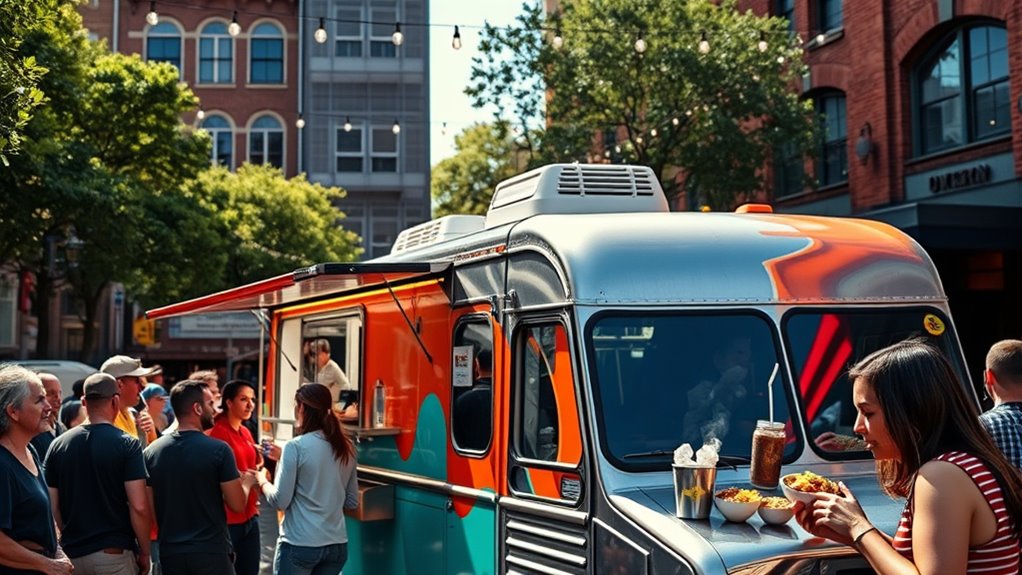
Austin’s food scene is booming, making it an ideal place to launch a food truck. With so many food lovers exploring diverse cuisines, your food truck branding can stand out by creating a memorable identity that resonates with locals and visitors alike. Engaging customers effectively is key; use vibrant visuals, unique menus, and social media to foster strong customer engagement. As more people seek authentic and innovative flavors, your ability to connect with your audience will drive repeat business. The city’s lively food culture offers ample opportunities to showcase your brand and build a loyal following. Incorporating diverse design options into your branding can further elevate your food truck’s visual appeal and attract a wider audience. By focusing on compelling branding and active customer engagement, you’ll thrive amidst Austin’s vibrant food scene and turn your food truck into a local favorite.
Understanding Local Requirements
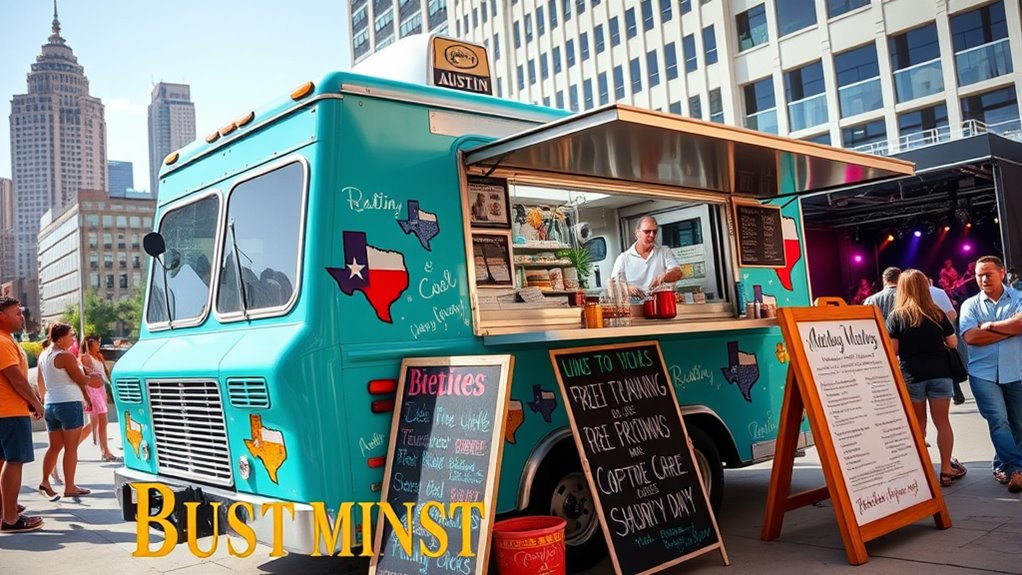
To get your food truck up and running in Austin, you need to understand the local requirements, starting with the online permit application process. You’ll also need to follow sanitation protocols and keep proper records to stay compliant. Additionally, knowing the designated zones for food trucks guarantees you operate legally and reach your customers effectively.
Online Permit Application Process
Finding your way through the online permit application process is a crucial step when starting your food truck in Austin. The city’s online permit system streamlines submitting your application, saving you time and effort. To begin, visit the Austin city website and create an account. Complete the application form, upload necessary documents, and pay the fee. Be sure to review all requirements beforehand to avoid delays. Keep track of your application status through the portal and respond promptly if additional information is requested. Below is a quick overview of key steps:
| Step | Description |
|---|---|
| 1 | Create an online account |
| 2 | Complete the application form |
| 3 | Upload required documents |
| 4 | Pay the application fee |
Successfully navigating this online permit process gets you closer to launching your food truck.
Sanitation Protocols and Recordkeeping
After submitting your online permit application, understanding and adhering to local sanitation protocols becomes essential to keep your food truck compliant and operational. Austin’s health department requires strict sanitation protocols to prevent contamination and ensure food safety. You’ll need to maintain proper cleaning schedules, store ingredients at correct temperatures, and use approved sanitizers. Recordkeeping is equally important; you must keep detailed logs of cleaning routines, temperature checks, and sanitation processes. These records demonstrate your commitment to compliance during inspections and help avoid violations. Regularly review Austin’s specific sanitation standards to stay current with any updates. By prioritizing sanitation protocols and diligent recordkeeping, you’ll build a reputable, compliant food truck business that meets local health regulations.
Designated Food Truck Zones
Understanding the designated food truck zones in Austin is essential for operating legally and smoothly. The city has specific zones where food trucks are permitted to park and serve customers, and these are outlined by zoning restrictions. Before setting up, you need to obtain the appropriate food truck permits that confirm your compliance with local regulations. These permits often specify which zones are accessible and any restrictions you must follow. Ignoring zoning restrictions can lead to fines or shutdowns. It’s vital to review the city’s zoning maps and regulations thoroughly to identify suitable locations. Planning your operations around designated zones not only keeps you legal but also helps attract customers in high-traffic areas, boosting your business’s success from the start.
Setting Up Your Base of Operations
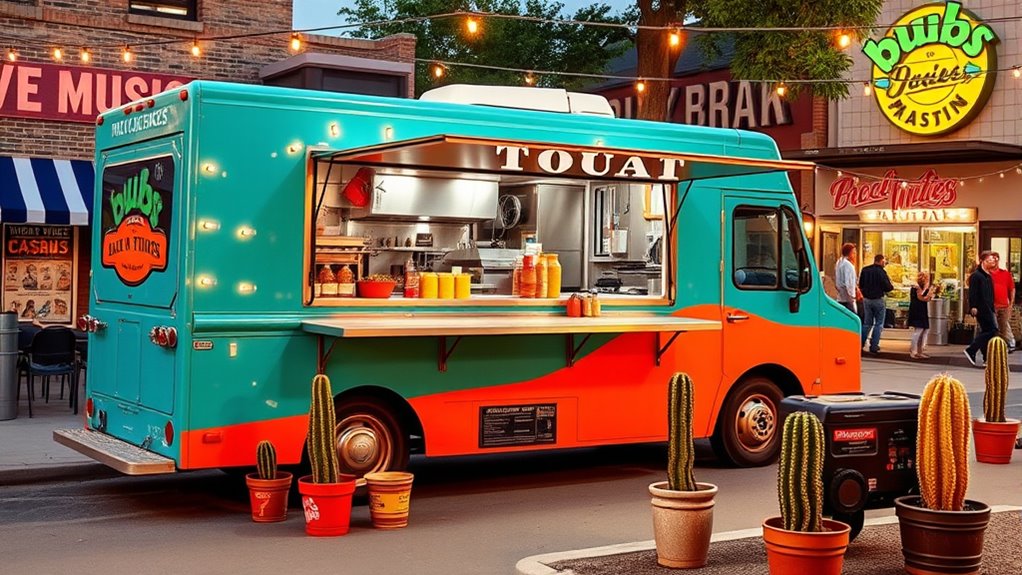
Choosing the right kitchen setup is key to launching your food truck smoothly. You can explore shared kitchen licensing options or invest in custom kitchen equipment tailored to your menu. Consider what best fits your budget and operational needs to establish a solid base of operations. Incorporating self-awareness into your planning can help you identify the most efficient layout and equipment choices for your specific goals.
Shared Kitchen Licensing Options
Setting up your food truck in Austin often means exploring shared kitchen licensing options, which can substantially reduce startup costs and streamline your operations. Shared kitchens allow you to operate under a single license, making it easier to comply with food safety regulations without investing in a dedicated facility. These kitchens are already equipped to meet health standards, helping you avoid costly delays and fines. By using shared kitchen licensing, you can focus on perfecting your menu and building your brand while ensuring your food safety practices are up to code. Many shared kitchens offer flexible hours and scalable options, making it easier to grow your business over time. This approach simplifies licensing and helps you get your food truck on the road faster.
Custom Kitchen Equipment Selection
Once you’ve secured a shared kitchen license, selecting the right custom kitchen equipment becomes your next priority. Your equipment selection directly impacts your food truck’s efficiency, quality, and safety. Focus on choosing durable, space-efficient custom kitchen equipment tailored to your menu needs. Prioritize essential items like commercial-grade stoves, refrigeration units, and prep stations. Consider workflow when designing your setup to minimize movement and maximize productivity. Research vendors who specialize in food truck equipment to ensure you get reliable, compliant options. Remember, investing in quality equipment can save you money long-term through fewer repairs and better performance. Take your time to compare features and prices, and don’t forget to verify that your choices meet local health and safety standards.
Budgeting and Financing Your Food Truck

Starting your food truck requires careful budgeting for costs like the initial vehicle purchase and ongoing expenses. You should explore financing options such as small business microloans to cover these costs. Additionally, make sure to budget for liability coverage and understand your tax filing responsibilities to keep your business compliant. Be aware of potential regulatory compliance challenges that may arise with new payment solutions.
Initial Vehicle Purchase Costs
Purchasing your food truck is a significant upfront investment, and understanding your options can help you budget effectively. Initial vehicle costs vary based on whether you buy new or used. A new food truck typically ranges from $70,000 to $150,000, offering the latest features and reliability. Used trucks can cost between $20,000 and $70,000, providing a more affordable entry point. When considering financing options, you might explore equipment loans, small business loans, or leasing arrangements to spread out payments. Keep in mind that additional costs like customization, licensing, and permits will add to your overall expenses. By understanding these initial vehicle costs and available financing options, you can plan your budget more accurately and make informed decisions as you start your food truck journey.
Small Business Microloans
If you’re looking for a flexible financing option to fund your food truck, small business microloans can be an excellent choice. These loans typically have lower borrowing limits, making them accessible if you’re just starting out or have limited collateral. To access funding opportunities, you’ll need to complete a straightforward microloan application, highlighting your business plan and repayment ability. Microloans can cover essential expenses like equipment, permits, and initial inventory. They often come with favorable terms and manageable repayment schedules, easing cash flow concerns. By exploring microloan options from community lenders, nonprofits, or online platforms, you increase your chances of securing the funding you need without the hassle of traditional bank loans. This approach helps you start strong and keeps your budget on track.
Liability Coverage and Tax Filing
Securing proper liability coverage and managing your tax obligations are key components of budgeting and financing your food truck. Liability insurance protects you from potential claims and accidents, safeguarding your assets. Staying on top of tax compliance ensures you avoid penalties and maintain good standing with authorities. To stay organized, consider this quick guide:
| Coverage Type | Purpose | Important for |
|---|---|---|
| Liability Insurance | Protects against claims | All food truck owners |
| Sales Tax Filing | Ensures proper tax collection | Operating in Austin, TX |
| Income Tax Payments | Meets tax obligations | Year-end filings |
| Record Keeping | Simplifies compliance | Audits and deductions |
Focusing on these essentials helps keep your food truck financially sound and compliant.
Designing Your Menu and Pricing Strategy
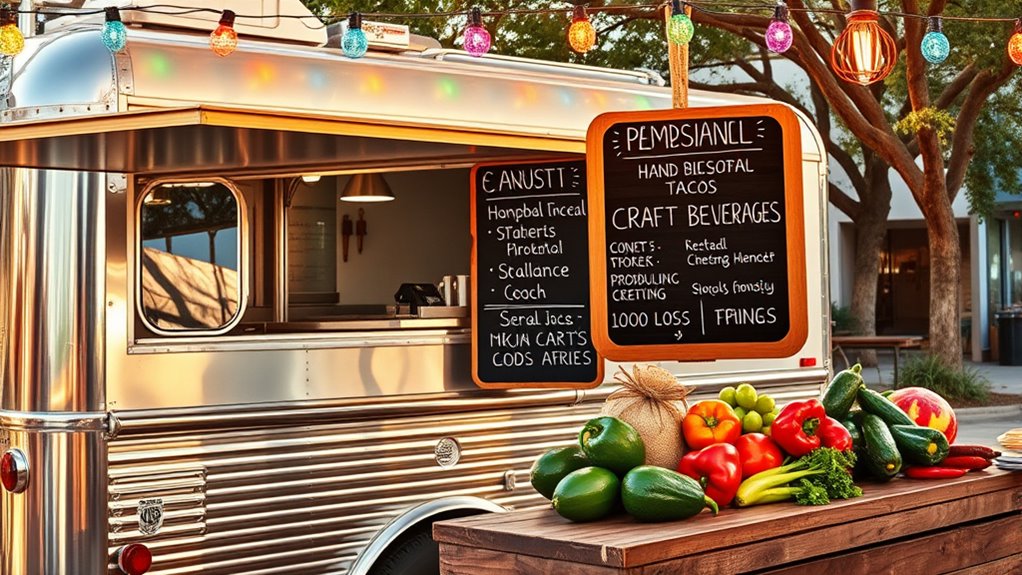
To stand out in Austin’s competitive food scene, focus on sourcing unique ingredients that excite your customers. Setting your prices to guarantee high margins requires balancing affordability with your costs and perceived value. By fine-tuning both your menu and pricing, you’ll attract loyal patrons and boost your profits. Incorporating custom modifications similar to vehicle tuning can optimize your offerings for better customer satisfaction and operational efficiency.
Unique Ingredient Sourcing Strategies
Innovative ingredient sourcing can set your food truck apart by allowing you to craft a unique menu and establish competitive pricing. By focusing on locally sourced, artisanal ingredients, you can create dishes that highlight freshness and quality. To maximize this approach, consider these strategies:
- Build relationships with local farmers and suppliers for consistent access to fresh, seasonal ingredients.
- Attend farmers’ markets to discover unique artisanal products not available elsewhere.
- Collaborate with community-supported agriculture (CSA) programs for exclusive ingredients.
- Incorporate foraged items, like wild herbs or mushrooms, to add distinctive flavors.
These tactics not only enhance your menu’s appeal but also foster loyalty among customers seeking authentic, local cuisine.
Pricing Strategies for High Margins
Creating a profitable menu starts with careful pricing that balances customer appeal and high margins. To implement effective pricing strategies, consider how each item contributes to your profit margins. Price too high, and you risk losing customers; too low, and margins suffer. Use the table below to analyze your options:
| Item Type | Cost | Suggested Price |
|---|---|---|
| Gourmet Tacos | $3 | $8 |
| Sides | $1 | $4 |
| Drinks | $0.50 | $2 |
| Desserts | $2 | $6 |
Focus on high-margin items by adjusting prices strategically, ensuring each dish maximizes profits without deterring customers. Proper pricing strategies help sustain your food truck’s profitability in Austin’s competitive market.
Technology and Operations
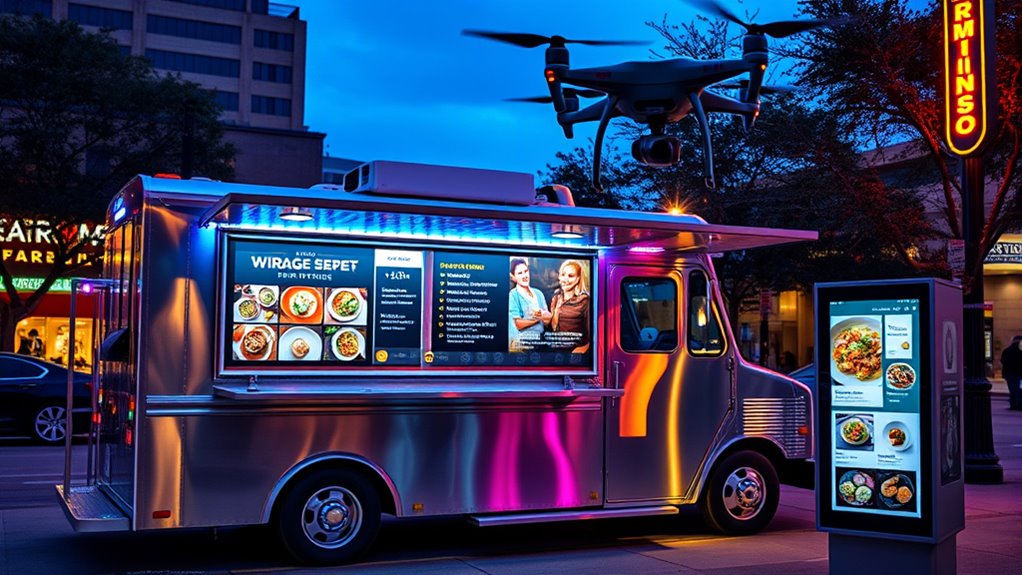
Using mobile card readers makes transactions faster and smoother for your customers. Real-time stock tracking helps you stay on top of inventory and avoid shortages. Incorporating these technologies streamlines your operations and keeps your food truck running efficiently. Upgrading your performance systems can further optimize engine efficiency and overall performance.
Mobile Card Readers for Quick Transactions
Mobile card readers are essential tools for ensuring quick and seamless transactions at your food truck. They enable cashless payments, reducing wait times and increasing transaction speed. Choosing the right device impacts your efficiency and customer satisfaction. Consider these factors:
- Compatibility with your smartphone or tablet
- Security features to protect sensitive data
- Ease of use for fast processing
- Connectivity options like Bluetooth or Wi-Fi
A reliable mobile card reader streamlines sales, minimizes errors, and keeps lines moving swiftly. With cashless payments becoming the norm, your ability to accept cards and mobile wallets directly influences your revenue flow. Investing in quality technology guarantees you deliver quick, secure transactions, helping your food truck operate smoothly and attract repeat customers.
Real-time Stock Tracking Software
Efficient stock management is essential to keep your food truck running smoothly and meet customer demand. Real-time stock tracking software streamlines inventory management by providing instant updates on stock levels, reducing waste, and preventing shortages. It also enhances supply chain logistics, ensuring you order ingredients just in time. With this technology, you can monitor sales trends and adjust inventory accordingly, saving money and boosting efficiency. Here’s a quick overview:
| Feature | Benefit | Impact |
|---|---|---|
| Automated Updates | Accurate stock levels | Fewer stockouts or excess |
| Integration | Seamless supply chain logistics | Faster restocking |
| Analytics | Data-driven decisions | Increased profitability |
Marketing and Growing Your Presence
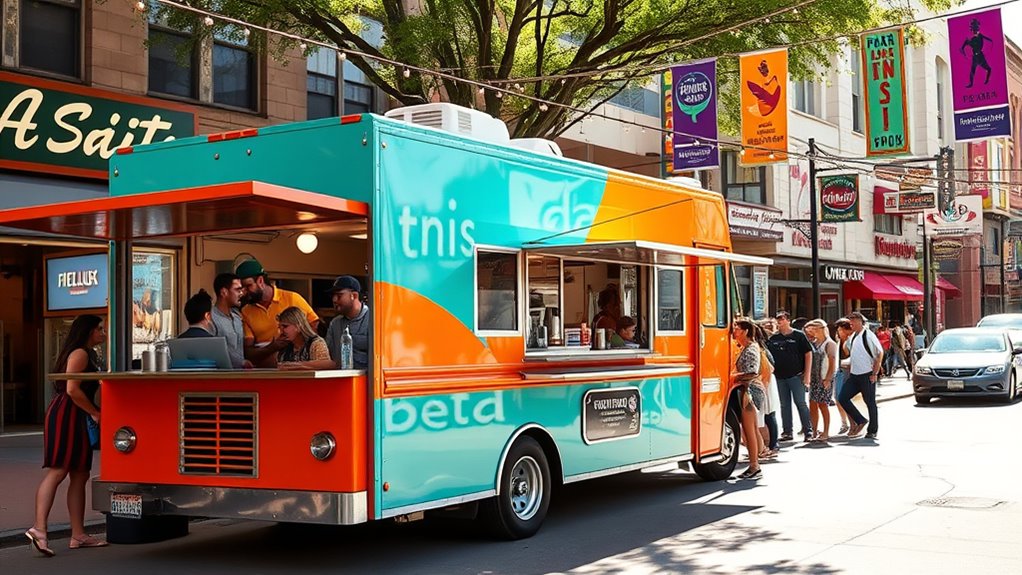
To boost your food truck’s visibility, consider hitting popular festival routes where crowds gather. Partnering with local food bloggers can also help spread the word and attract new customers. These strategies can considerably grow your presence in Austin’s vibrant food scene.
Popular Festival Route Options
If you want to boost your food truck’s visibility in Austin, hitting popular festival routes is a smart strategy. Focus on festival route planning by selecting events with high foot traffic and diverse audiences. To maximize your presence, consider these options:
- Partner with local event organizers to secure prime spots.
- Attend seasonal festivals like SXSW, ACL, or the Texas Book Festival.
- Join food truck circuits that rotate through popular neighborhoods.
- Leverage event partnership strategies to co-promote with vendors or sponsors.
Local Food Bloggers Collaborations
Partnering with local food bloggers can considerably boost your food truck’s visibility and credibility in Austin. Food blogger partnerships are a powerful tool for influencer marketing, helping you reach wider audiences and build trust quickly. By collaborating with passionate local influencers, you create authentic buzz around your menu and brand. These relationships evoke excitement, loyalty, and community support. Consider this emotional impact:
| Excitement | Trust | Community |
|---|---|---|
| Discover new flavors | Authentic recommendations | Be part of Austin’s food scene |
| Unique experiences | Personal connections | Shared love for local cuisine |
| Viral exposure | Credibility boost | Support local businesses |
Local Events Can Boost Sales
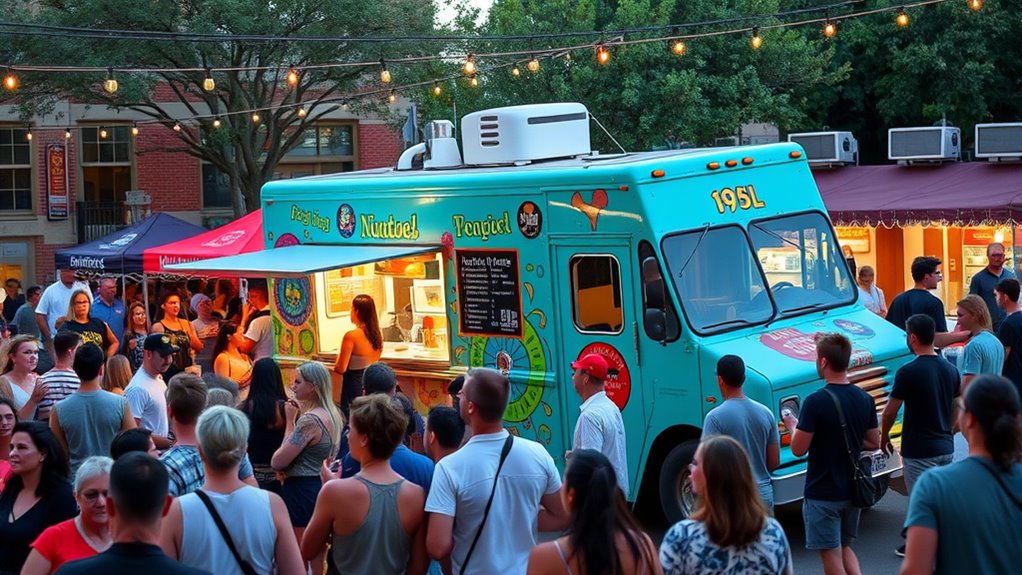
Attending local events is a proven way to boost your food truck’s sales and build a loyal customer base in Austin. These gatherings provide opportunities to enhance your food truck branding and increase social media engagement. To maximize benefits, consider these strategies:
- Choose events that align with your target audience to attract loyal customers.
- Use eye-catching signage and branding to stand out amidst the crowd.
- Engage attendees with live updates and behind-the-scenes content on social media.
- Offer exclusive event deals to encourage repeat visits and word-of-mouth promotion.
Participating consistently helps you establish a presence in the community and fosters relationships that translate into long-term sales growth. Local events are not just sales opportunities—they’re branding opportunities.
Frequently Asked Questions
What Permits Are Needed for Night-Time Food Truck Operations in Austin?
To operate your food truck at night in Austin, you’ll need night time licensing and late night permits from the city. You must apply through the Austin Public Health Department and guarantee your truck meets all health and safety standards. Additionally, check if specific zoning or parking permits are required for late night operations. Securing these permits ensures your night-time food truck business runs smoothly and legally.
How Can I Find Reliable Food Truck Suppliers in the Austin Area?
You can find reliable food truck suppliers in Austin by researching local vendors online and reading supplier reviews. Visit farmers’ markets and food industry events to connect with trusted vendors firsthand. Ask fellow food truck operators for recommendations, and check online directories for verified suppliers. By focusing on local vendors and carefully reviewing their reputation, you’ll guarantee you get quality ingredients and equipment for your food truck business.
Are There Specific Health Regulations Unique to Austin’s Food Trucks?
Like a tightrope walker balancing carefully, you need to navigate Austin’s specific health regulations. Austin’s food trucks must pass local health inspections, which focus on food safety standards unique to the city. These include proper food storage, sanitation, and equipment requirements tailored to Austin’s vibrant food scene. Staying current with Austin food safety regulations guarantees your truck remains compliant, avoiding fines and maintaining your reputation on the bustling local streets.
What Are the Best Locations for Food Trucks During Austin’s Festivals?
During Austin’s festivals, you should target popular festival locations like Zilker Park, Auditorium Shores, and the Waterloo Park area for food truck parking. These spots attract large crowds, providing great visibility and sales opportunities. Coordinate with event organizers early to secure permits and designated spaces. Position your truck near entrances or main event stages to maximize foot traffic, ensuring you get the most out of festival days.
How Can I Build a Loyal Customer Base in Austin’s Competitive Food Scene?
You can build a loyal customer base in Austin’s competitive food scene by focusing on customer loyalty and social media engagement. Offer consistent quality, listen to feedback, and create a unique brand experience. Use social media actively to share your story, promote specials, and engage with followers. Respond promptly to comments and reviews, and encourage satisfied customers to spread the word. Over time, these efforts will turn first-time visitors into regular fans.
Conclusion
Starting a food truck in Austin means opening the door to a vibrant city full of flavor and opportunity. With your passion and the right planning, you’ll be weaving your culinary story into Austin’s lively tapestry. Think of your truck as a rolling beacon of delicious dreams, ready to captivate hearts and taste buds alike. Embrace the journey, and watch your food truck become a beloved fixture in this city’s bustling rhythm of life.
